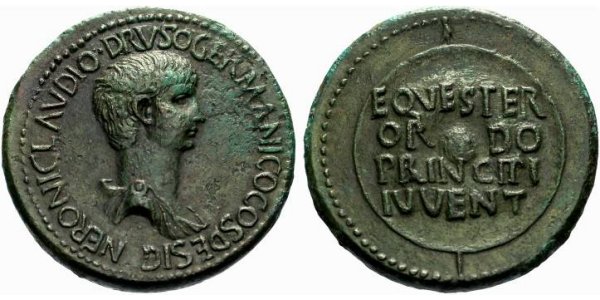
Numismatica Ars Classica NAC AG >Auction >Auction 27 (12.05.2004)
 |
| 写真提供:Numismatica Ars Classica NAC AG
|
 超拡大ボタン 超拡大ボタン |
| |
|
|
|
Numismatica Ars Classica NAC AG >Auction >Auction 27 (12.05.2004)
Lot :330
Price :13000 CHF (~10060 USD)
Description
The Roman Empire
Nero Caesar, 50-54
No.: 330
Estimate: CHF 15000
d=37 mm
Sestertius, Thrace circa 51-54, 29.66 g.
NERONI CLAVDIO DRVSO GERMANICO COS DESIG Bare-headed and draped bust r. Rev. EQVESTER / OR - DO / PRINCIPI / IVVENT on shield with vertical spear behind. C 99. BMC p. 195, note. CBN Claudius 288. RIC Claudius 108. RPC 319. Von Kaenel, SNR 63, N4 and pl. 25, 38
Very rare and possibly the finest specimen known. Fine green patina and struck on a very broad flan with some area of porosity on obverse,otherwise about extremely fine / extremely fine
Only two issues bronzes were struck for Nero as Caesar under Claudius: a sestertius of the type offered here and a companion dupondius, both of which replicated designs found on the aurei and denarii Claudius also struck for his adoptive son. These bronzes are from a series of Imperial coins struck in Thrace, perhaps at Perinthus, which included coins in the name of Claudius' natural son Britannicus, and Agrippina Junior, who was Claudius' wife and Nero's mother. The sestertius bears a round shield inscribed EQVESTER ORDO PRINCIPI IVVENT (""the equestrian order to the prince of youth"") set upon a spear. This is an ideal representation for the high honors described in the inscription, as it was traditional for the Order of Roman Knights to present Princes of Youth with a silver spear and a small shield known as a buckler. The dupondius shows four priestly implements and bears the inscription SACERD COOPT IN OMN CONL SVPRA NVM, revealing that Nero was simultaneously adopted into all of the high priesthoods (colleges), and that he did so above the usual number (i.e. admitted as supernumerary). The four implements shown were either worn by priests or were used in divination or sacrifices. Each represented a different priestly college: the simpulum for the pontificate, the lituus for the augur (soothsayer), the tripus (tripod) for the quindecimvirate Sacris Faciundis (who had charge of the Sibylline oracles), and the patera for the septemdecimvirate (septemvir epulo) whose responsibilities included festivals.
show10goo 無断転用を禁止します。
| 
